Since launching the Canadian Film & Photo Unit website, I have received many emails from individuals seeking more information about the men and women that made up the Unit. However, I have never received an email quite like the one I received from Laurent, who sent me an email from Paris, France, in February, 2014.
Instead of a question, Laurent sent me a link to a photo from his collection; an inspirational full size replica of a Canadian combat cameraman, comlplete with patch, and Speed Graphic camera, based on photos of Lt. Don Grant, and Lt. Frank Dubervil.
Laurent’s project stemmed from an interest inspired by his Uncle (a former member of the SOE Special Operations Executive), who took Laurent as a child to Normandy on June 6th, to celebrate D-Day. I have included Laurents’ story here in his native French, along with an English translation…(thank you Caroline!)

****
Laurent de Miollis;
Je suis né à Paris, en 1961, dans une famille ou la guerre était encore très présente.
En 1971, mon Oncle, Claude Planel un ancien agent SOE durant ww2 m’offre pour mon anniversaire le livre de Donald Burgett : Currahee , des éléments de son uniforme et me fait faire un voyage en Normandie, ou je découvre les plages du débarquement et Sainte Mère Eglise. Depuis cette date, je me rends pratiquement tous les ans en Normandie au mois de Juin.
En 1992, alors que je travaillais pour une compagnie japonaise de jeu vidéo et que mon activité me conduit régulièrement à Tokyo, je découvre dans le quartier de Akihabara un homme qui dans une petite boutique vends un curieux appareil photo. J’achète cet appareil sans connaître, et rentré en France apprends qu’il s’agit d’un Speed Graphic utilisé par les Usmc dans le Pacific.
Une passion dévorante était née, je découvre que cet appareil à été utilisé par les photographes américains et Canadiens et au hasard de mes différents voyages essaye de trouver ces appareils pour les ramener en France.


Avec les années je parviens à reconstituer la valise entière d’un photographe Signal Corps, avec un appareil que je découvre dans une Ferme, en Normandie qui venait de passer 60 ans dans un poulailler. Je restaure cet appareil pour lui redonner vie.
Absorbé par mes activités professionnelles, je délaisse un peu les appareils et ma collection d’uniforme pour revenir vers eux il y a deux ans.
Mais je me tourne désormais vers le Commonwealth, et je décide de compléter l’uniforme de mon oncle en Afrique et à force de fréquenter des collectionneurs avertis, je découvre les Cfpu et une seule idée traverse mon esprit en permanence, connaitre ces hommes, reconstituer leur équipement j’ai la chance de faire la connaissance de Frederick M. Jeanne-McQueen auteur du livre Hold the Oak Line « histoire illustrée de la 7° brigade D’day » qui m’apporte une aide considérable dans la réalisation de mon projet. Sur internet, je découvre le site :https://canadianfilmandphotounit.ca et commence mes recherches sur les photographes Cfpu et l’histoire de cette unité.
Je découvre que la grande majorité des images que je vois depuis mon enfance sont des images de ces hommes. Je dois à ma manière rendre hommage à ces hommes, comment faire autrement qu’en reconstituant une tenue complète portée un matin de Juin 1944.


Je prends comme modèle les fabuleuses photographies du Lieutenant Grant et du Lieutenant Dubervill et commence à rassembler les pièces, dans le même temps je procède à la restauration d’un Speed Graphic de 1940 acheté plusieurs années auparavant au Canada sur ebay. Je voulais que mon mannequin soit prêt pour cette année anniversaire du d’day et grace à un ami, Pascal Auger, de Québec et grand collectionneur de matériel Canadien de ww2, je parviens à faire venir en France quelques pièces magnifiques tout en me dispensant des conseils et informations passionnantes.
Pièces après pièces, j’ai réussi à retrouver la plupart des éléments, pour aujourd’hui pouvoir présenter cet ensemble. J’ai envoyé la photograpfie à Monsieur Dale Gervais, sans qui rien n’aurait été possible.Il me reste quelques éléments à trouver, à compléter, particulièrement sur l’équipement, le type d’objectif, le transport de l’appareil, ou rangeaient ils les plans films, quelle était leur formation, il me semble que les appareils étaient leur propriété personnelles, tant de questions, tant d’interrogations, et un regret qui ne pourra jamais être réparé, pourquoi ne me suis-je pas posé ces questions il y à 20 ans …
Mes recherches continuent, je veux que ces hommes sortent de l’ombre dans laquelle ils sont plongés en France depuis si longtemps, qui sait que ce film extraordinaire du débarquement à Juno Beach est l’œuvre d’un Cfpu, et que nos livres d’histoires sont remplis de photographies de ces hommes. Donc le travail continu, et chaque jour des choses passionnantes apparaissent. Les prochaines étapes sont de reconstituer la tenue d’un Cfpu affecté Airborne et de compléter l »équipement photographique, en attendant le 6 juin prochain, pour me trouver sur Juno Beach à l’aube pour communier et rendre un hommage à tous ces hommes sans qui je n’aurait pas la chance d’être un Homme Libre aujourd’hui..
English translation;
I was born in Paris in 1961, into a family for which war was still very present.
In 1971, my uncle Claude Planel, former SOE agent during WWII, gave me a book by Donald Burgett, entitled, Currahee, as well as parts of his uniform and takes me on a trip to Normandy, where I discovered the landing beaches and a place called Sainte Mère Église. Since that first trip, I make an annual pilgrimage to Normandy almost every June.
In 1992, while I was working for a Japanese video game company, and for which I was travelling frequently to Tokyo, I discovered a small boutique in the Akihabara quarter which had an interesting looking camera. I bought this camera without knowing and when I returned to France, I learned that it was a Speed Graphic used by the USMC in the Pacific.
This purchase ignited in me a passion – only to discover that the camera was used by American and Canadian photographers. I also became interested in trying to find more of these cameras and bring them back with me to France.
Over the years, I was able to « reconstruct » an entire suitcase or briefcase belonging to a Signal Corps photographer, thanks to a camera I found on a farm in Normandy, stored in a chicken coop for sixty years. I am now restoring this camera to give it new life.
Absorbed by work related activities, I had to put aside the cameras and uniform collection until I came back to it about two years ago.
Then I decided to focus on the Commonwealth and to complete the uniform belonging to my uncle, who fought in Africa. The more I frequented collectors, I discovered the CFPU. One single thought crossed my mind – it was to know these men and to reconstruct their equipment. I was able to meet Frederick M. Jeanne –McQueen, author of the book, Hold the Oak Line, illustrated history of the 7th brigade – D-Day. This provided much help in the development of my project. On the internet, I discovered the website:https://canadianfilmandphotounit.ca, and began my research on the photographers and the history of the unit.
I discovered that the majority of the photos that I’ve seen since my childhood are photos of these men. I must somehow, in my own way, honor these men, by making a complete uniform worn on a June morning in 1944.
I use the wonderful photos of Lt. Grant and Duberville that serve as models and I begin collecting pieces. I also begin restoring the 1940 Speed Graphic that I purchased in previous years from Canada on e-Bay. I wanted my mannequin to be ready for the D-Day anniversary and thanks to my friend Pascal Auger from Québec, who is a big collector of WWII Canadian military material, I was able to purchase a few wonderful pieces. He also provided much background and fascinating history.
Piece by piece, I was able to locate most of the uniform, so that today I am able to present this officially. I sent the photo to Mr. Dale Gervais, without whom none of this could have been possible.
I still have a few things to locate, to complete, and in particular, the equipment, the lens, the transport of the equipment, the storage of the stock, as well as what was their training. It seems to me that the equipment was their own personal property; I have so many questions and queries, and a deep regret that cannot be undone – why did I not turn my focus on this sooner, twenty years ago…

My research continues and I want these men to come out of the shade into which they dove in for so long now in France. Who knows if this wonderful film of the landing at Juno Beach is the masterpiece of a CFPU member, and that our history books are filled with photos taken by these men. So the work continues and every day I find passion in many things. The next step is to work on the uniform of a CFPU airborne soldier and to complete the photographic equipment, until June 6th next, when I’ll be on Juno Beach at sunrise, to commune and honour all these men without whom today, I would not be a free man.




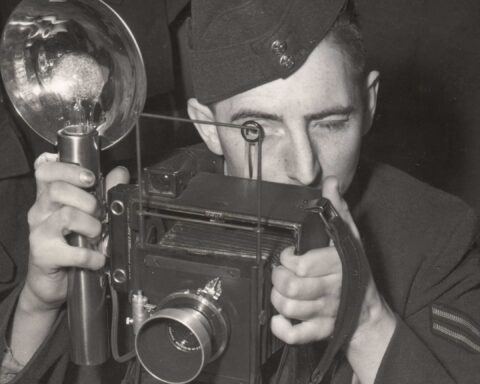



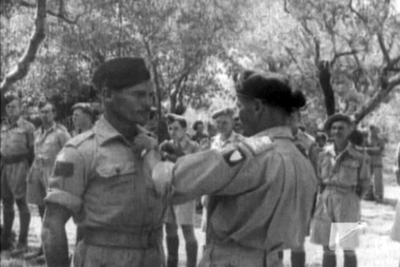
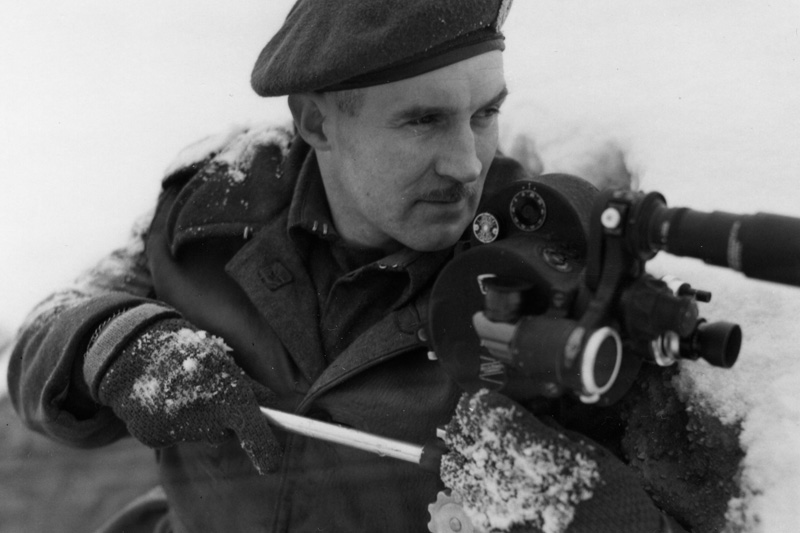

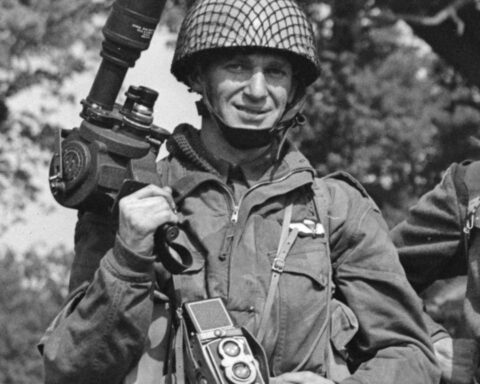
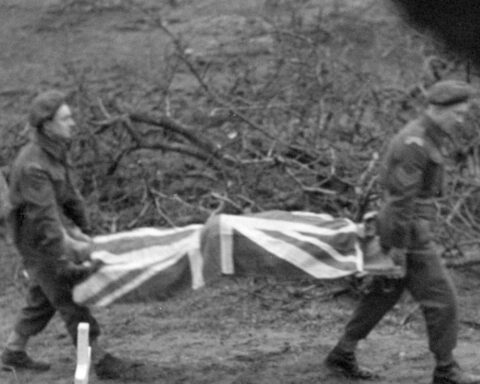
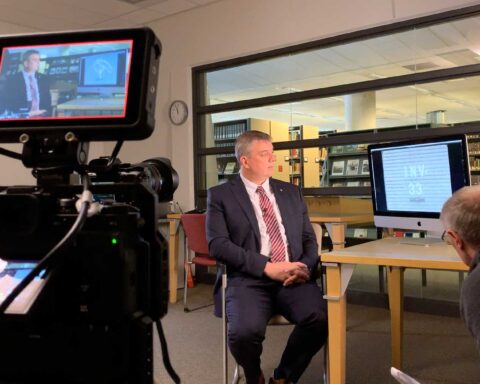

Many thanks for the fantastic Memorial job from Dale.
Cheers,
Laurent de Miollis